Auxiliary Lines of Ear Acupuncture
Every ear is of a slightly different shape so that the beginner often finds it difficult to search for points. However, there are certain common features of proportion that are independent of the overall features of the ear relief, and these features seem to be the same on every ear.
Based on these regularities it is thus possible to use auxiliary lines that are generally applicable, thus making it easier to find a number of important points.
This fact is particularly impressive in the case of the various lines running through Point Zero. It is always surprising to see that these points are indeed arranged exactly on a straight line. Hence, if two of the points are known, the other points on the line can be easily found (with the aid of a ruler).
Surprisingly, this applies to ears of all shapes. Likewise, many structures on the ear have fixed anatomical or geometric relationships to each other.
The auxiliary lines described below are extremely helpful in finding the accurate location of the searched-for areas on the ear. However, the lines are only useful if time is first taken to establish them on the ear. Beginners, in particular, should mark the lines with a fine marker prior to searching for points. The experienced therapist works by eye.
Barbiturate Analogue Point, Caffeine Analogue Point
Auxiliary line:
The horizontal line running through Point C7. The line first crosses the Shoulder Joint Point in the scapha and then the Barbiturate Analogue Point in the groove of the descending helix (Zone of Sympathetic Nuclei of Origin).
Barbiturate Analogue Point and Caffeine Analogue Point have identical locations but differ in the needle metal required:
The Barbiturate Point appears as Silver Point on the right ear and as Gold Point on the left ear. The Caffeine Point appears as Gold Point on the right ear and as Silver point on the left ear.
Note: Two points are required for establishing a straight line, but a single point is sufficient for establishing a horizontal or vertical line.
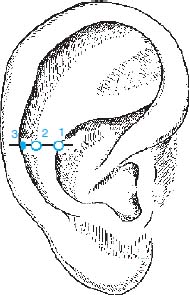
Fig. 7.1
1 Point C7
2 Shoulder Joint Point
3 Barbiturate Analogue Point
Omega Points
Auxiliary line:
A vertical line runs through all three Omega Points.
Aggression Point
Auxiliary line:
The vertical line through the three Omega Points runs also through the Aggression Point. (For another auxiliary line through the Aggression Point, see Auxiliary Lines Near the Tragus, p. 307).
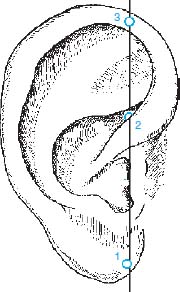
Fig. 7.2
1 Master Omega Point
2 Omega Point I
3 Omega Point II
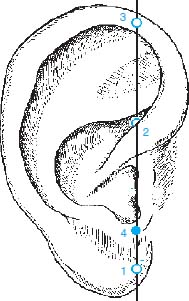
Fig. 7.3
1 Master Omega Point
2 Omega Point I
3 Omega Point II
4 Aggression Point
Hormone Points
Auxiliary line:
A straight line through Point Zero and one of the three points for hormones: Estrogen Point, Gonadotropin Point, Progesterone Point. If only one of these points is known (because it was found to be active), the other two points can easily be located by means of the auxiliary line.
As always, the rule applies that only active points should be needled.
By means of the auxiliary lines, however, the reflex areas to be examined are precisely located or circumscribed.
As a refresher:
The Estrogen Point is located on the inside (underside) of the ascending helix, about 2 mm away from the helical rim, halfway between Point Zero (Umbilical Cord Point) and Uterus Zone.
The Progesterone Point is located 4 mm away from the Kidney Point in the fold of the ascending helix.
The location of the Gonadotropin Point and further help in finding it are described in detail elsewhere (see pp. 137, 197).
Cortisone Point, ACTH Point
Auxiliary line:
Cortisone Point and ACTH Point are located on a straight line running through Point Zero.
If only one of the two points is known, the other one can be easily located by means of the line through Point Zero. (For precise locations of the Endocrine Points in the antihelical wall, see p. 194).
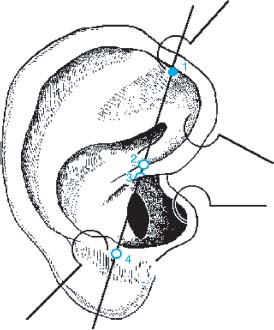
Fig. 7.4
1 Progesterone Point
2 Estrogen Point
3 Point Zero
4 Gonadotropin Point
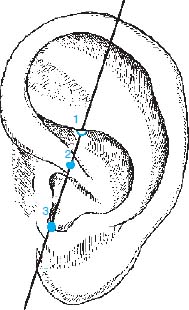
Fig. 7.5
1 Cortisone Point
2 Point Zero
3 ACTH Point
Thymus Gland Point, Interferon Point, Laterality Point
Auxiliary line:
Thymus Gland Point and Interferon Point are located on the straight line running through Point Zero and the Laterality Point.
Spleen Point, Diazepam Analogue Point
Auxiliary line:
The Spleen Point is located on a straight line running through Point Zero and the Diazepam Analogue Point, on the left ear.
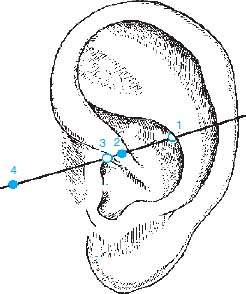
Fig. 7.6
1 Thymus Gland Point
2 Point Zero
3 Interferon Point
4 Laterality Point
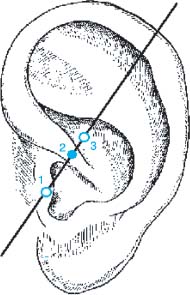
Fig. 7.7
1 Diazepam Analogue Point
2 Point Zero
3 Spleen Point
Depression Point, Tonsil Point, TMJ Point
Auxiliary line:
A straight line running through Point Zero and the postantitragal fossa, just anterior to Point C1 (Point C0/C1). At the end of the scapha, the line runs through the following reflex areas: Depression Point, Tonsil Point, Retromolar Space Point, and TMJ Point, all of which lie very close together.
The location of the Depression Point (Antidepression Point, Joy Point) is defined as “at the end of the helical groove” (where scapha and helix meet).
The end of the helical groove, however, may differ widely in its location and is often found further up. The auxiliary line is therefore important, especially for the beginner, because it ensures that this major reflex area of symptoms or foci will not be overlooked.
Trigeminal Nerve
Auxiliary line:
The same line described above which runs through Point Zero, postantitragal fossa, Depression Point, Tonsil Point, Retromolar Space Point, and TMJ Point.
On the extension of this auxiliary line at the edge of the ear lies the Trigeminal Nerve Zone (sensory portion on the front of the ear, motor portion on the back of the ear).
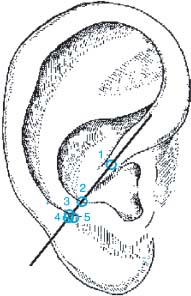
Fig. 7.8
Stay updated, free articles. Join our Telegram channel

Full access? Get Clinical Tree


